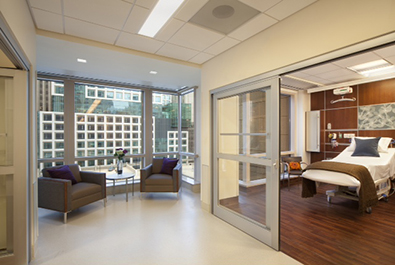HOK Awarded Citation of Merit
 CHICAGO — HOK, an architecture, engineering and planning firm, received a Citation of Merit from Behavioral Healthcare Magazine’s 2012 Design for Health and Human Services Showcase.
CHICAGO — HOK, an architecture, engineering and planning firm, received a Citation of Merit from Behavioral Healthcare Magazine’s 2012 Design for Health and Human Services Showcase.
The firm earned the award based on the design, planning and implementation for the new Northwestern Memorial Hospital’s Stone Institute of Psychiatry in Chicago. The project is a single-phase retrofit of an existing 38,000-square-foot floor. The total construction cost was slightly more than $11 million and the construction period took from 2007 to September 2011.
Previously a clinic floor, the main challenge HOK faced involved creating an inpatient, locked psych unit within the building while the existing facility was still providing several other services, including outpatient. Another significant challenge the company encountered was working with the preset systems in place on the floor.
“When we started this project, we originally thought that we could relocate some of the existing mechanical shafts and electrical rooms. And when we looked at, it we realized it was cost prohibited,” said Shelia Cahnman, the principal in charge of the project. “What we did was we had to work around all of the existing locations of the major shafts and electrical communication closets, which were designed and stacked for a clinic building, which is a different module if you’re going for an inpatient module. So we had to redesign the whole unit to make use of the existing conditions, which was a challenge.”
HOK partnered closely with staff, patients and families to complete a comprehensive design that complimented the institution’s “Patient First” mission.
“It is an honor to be recognized by the health care industry and your peers,” said Vlad Torskiy, vice president of health care at HOK’s Chicago office. “Our mission is to design and construct buildings that help heal people. It is extremely meaningful for us to give back to a group of patients who are especially vulnerable.”
With most existing, inpatient psychiatric care models using designs from the 1960s and1970s, the under-funded institutions have faced challenges in remaining up-to-date and providing for the current needs of patients and caregivers.
HOK responded to these difficulties by creating a space that allows patients to maintain privacy, dignity and safety. Following “the model of life” care concept, patients have both private and shared spaces that encourage integration back in to society.
The team also created “off-stage” and “on-stage” zones, which have varying degrees of access and control. Direct caregivers and patients have access to “on-stage” zones while staff, the public and clinical support use “off-stage” areas. The system helps eliminate blind spots as well as aid patients and staff.
The company wanted hospital stays to be as comfortable as possible and provide patients with sense of home. However, patient security is paramount. Designs had to meet the highest security standards and prevent patients from leaving leave the unit.
“One of the things that was really great about this project was the staff on the psychiatry unit stayed consistent throughout the whole project and was very motivated. It was really great at the end when we opened to go see the nurses and it was all the same nurses we had started with years before,” said Cahnman.
